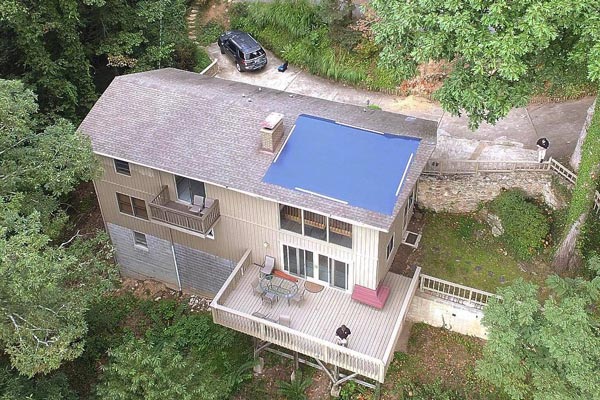Tree Damage
A roar of thunder, a vicious gust of wind or an electrifying strike of lighting is what trees are forced to weather during the storm while we stay indoors. With a lightning strike or severe storm is all it takes for one tree to come crashing on your home. Hopefully your are safe and not at home. But the fall of a tree on your home while inside can be one of the most alarming events in your life. Tree damage can affect many different parts of your home just from one tree falling.
Steps After A Tree Falls
Tree Removal - while we don't do the tree removal ourselves we can recommend a highly skilled professional tree removal company.
Board Up & Tarping - after a tree strikes your home it will cause damage to the roof, windows and possibly expose other areas of your home. We need to get your home tarped and protected from the weather elements so you don't incur additional damage.
- Tree Damage Repairs - we will work with your insurance adjuster in coming up with a scope of work and pricing to repair all the damage incurred by the fallen tree. Capital Restoration is a licensed general contractor and can complete any tree damage project from beginning to end.
Storm Damage
Some of your trees may incur damage after a storm and it's important you check on the trees near your home to determine if it's safer to actually remove the tree before it falls on your home.
Assessing the damage.
Splitting or splintering of the trunk, large broken branches, split crotches, and removal of bark, can occur when there is strong wind or ice storm. The first question you should ask yourself when a tree is severely damaged is: if the condition of the tree is still worth keeping and does it have a high probability of falling during a future storm. You might not be able to answer this question, and will need the help of a professional arborist. It might be smarter to remove the tree in advance to avoid future tree damage.
What to Do When You Find a Broken Tree Limbs or Tree Damage
To prevent damages on small broken branches, you can prune them.
• Avoid pruning large or high branches as it is advisable to hire a tree professional to do this.
• Prune broken limbs and remove the branch and smooth the wood with a saw back to the point where they join a larger branch.
• Check if the tree’s crown is still intact.
• Do not cut the top off a tree as this can affect the tree structure and leave it vulnerable to infestation.
• Assess whether most of your tree’s canopy is undamaged, it can usually stay afloat and if you might have to remove the tree if your tree lost more than 50 percent of its top.
• Your professional will be able to give you a definite answer and provide next steps after seeing and assessing the tree.
Don't Try to Do It All Alone
Just as we have stated earlier, your tree might have hidden damages and you won't be able to tell if you are not a professional and in cases like this, you may need a tree professional to help you decide what to.




